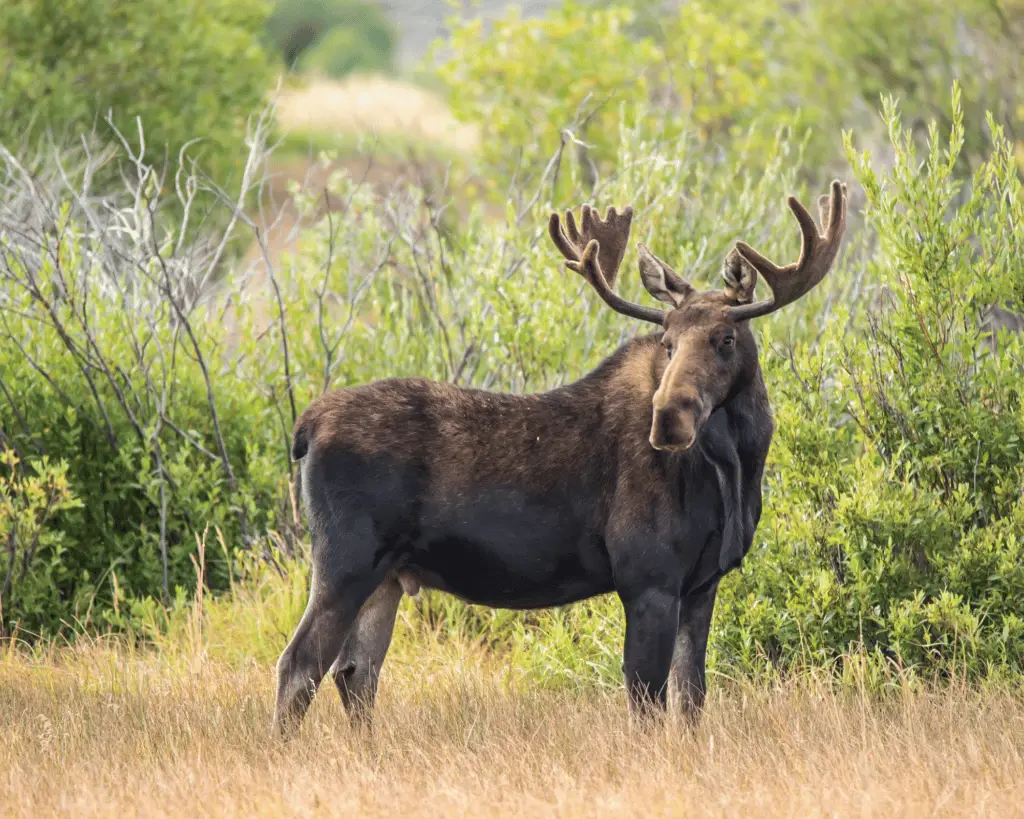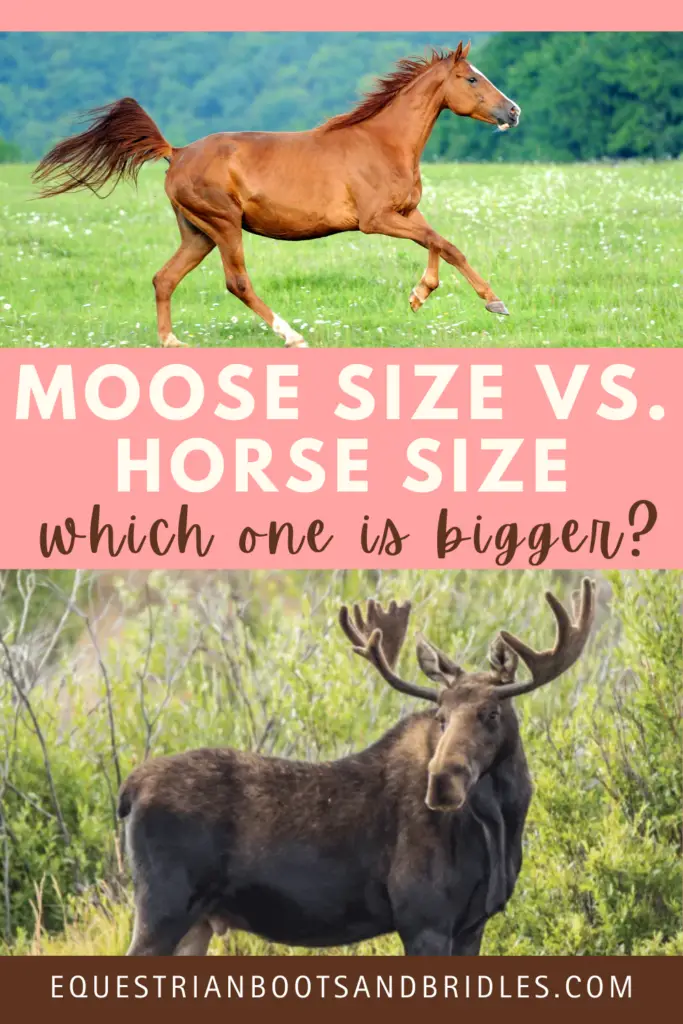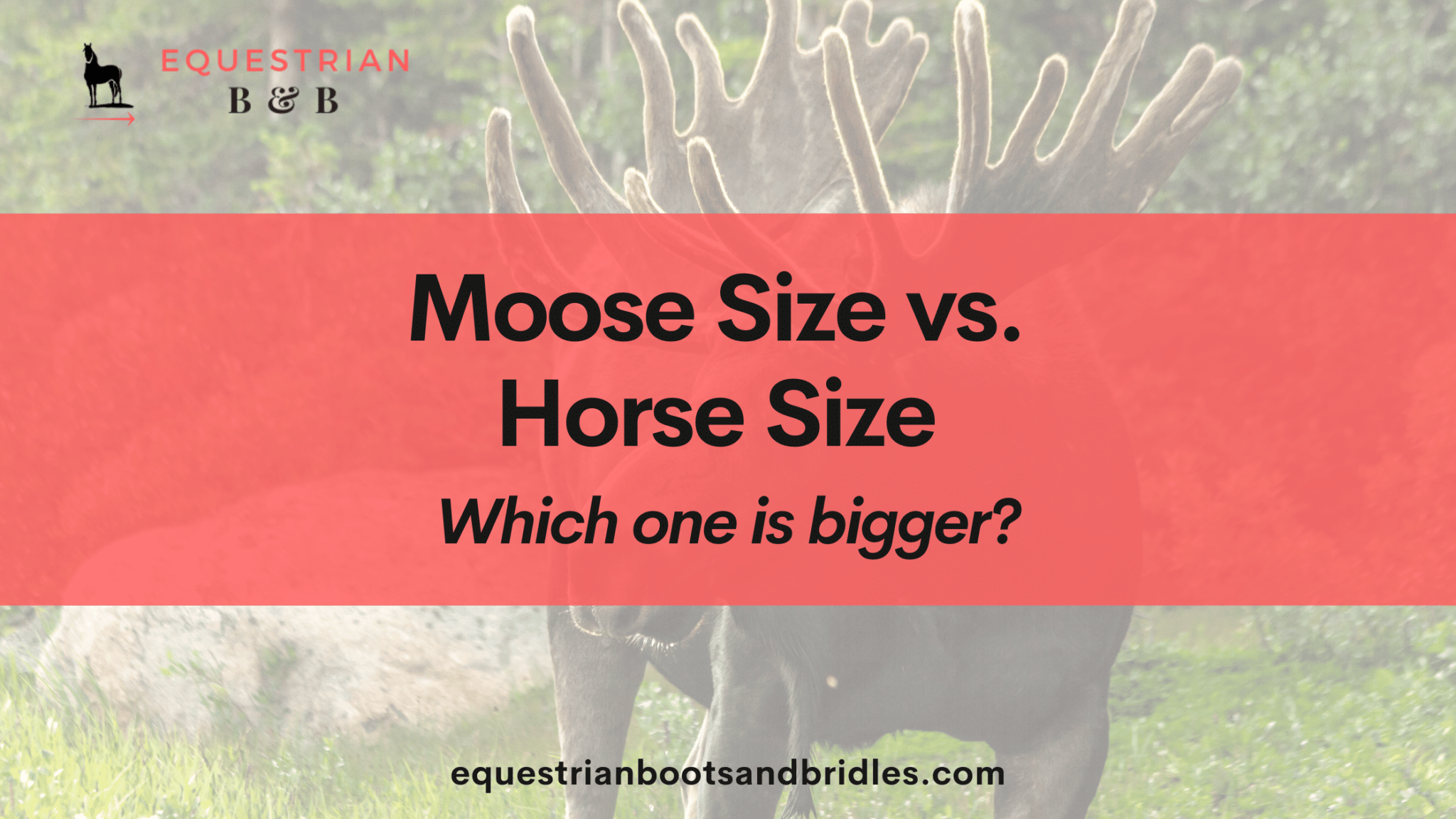Have you ever looked at a moose out on the range and wondered what it would be like to ride them? Most horse people will have this momentary thought, but given the sheer size of a moose vs horse, they’d quickly change their minds!
However, I got to thinking about the size of a moose and the size of a horse, and I tried to quantify the differences in ways that made sense (just in case you decide you want to ride one anyway).
Comparisons of a Moose Size Vs Horse Size
To start out, I needed a few basic ways to compare the two animals. So I considered overall size, height, weight and bulk, physical differences, and lifespan of horse breeds and different moose breeds.
Moose Size Compared to Horse Size
On average, moose are bigger, taller, and heavier than horses. Of course, this comparison is for the average-sized horse breeds like Appaloosas, thoroughbreds, Arabian horses, and quarter horses. A giant size draft breed such as a Clydesdale horse or Belgian draft horse would definitely give a moose a run for its money on size and height.
Average horses weigh 600-1,200 pounds, while a mature moose weighs in at 600-1,500 pounds. The difference in weight isn’t huge, and with moose, the massive antlers often contribute significantly to their weight and size.
Horse’s Height Compared to Moose Height
The average moose height is around 6 to 7 feet, while most horses stand far below 6 feet at the withers. The largest moose stood to a height of 7.6 feet at the wither, while the largest horse reached 6.10 feet at the wither.
The Yukon moose is the tallest moose, while draft horses like the Clydesdale or Belgian draft are the tallest horses ever measured. Overall, the moose is the taller animal, especially when considering the extra height of their antlers.
Moose Weight and Bulk Compared to Horses
Horses and moose weigh similar amounts. The average horse weight and moose weight is both about 600 to 800 pounds. There are some draft species of horses that weigh in at a bulk of 1,200 pounds, while moose can reach a weight of well over 1,500 pounds. The heaviest moose ever weighed was an Alaskan moose that weighed an impressive 1,806 pounds.
The Alaskan moose is also the largest of the moose subspecies. So the massive weight and extra height of these giant moose is somewhat above normal for moose.

Physical Differences Between Moose and Horses
The most obvious differences between a moose compared to a horse is in their physical appearance.
- Antlers vs None
For starters, the most obvious difference is that moose have a huge set of antlers that add significantly to their overall height. Horses have longer necks than a moose, which can raise their heads quite a bit off the ground, but without a set of horns or antlers (unless you believe in unicorns), horses are dwarfed by the antlers of the moose.
- Hooves and Toes
Another obvious difference is that moose have cloven hooves with a set of dew claws that help them traverse rugged terrain at impressive speeds. A horse’s hooves are a full halfmoon shape, but the horse’s “toe” has been reduced by evolution to the ergot that we see on the back of each fetlock.
Moose don’t need their cloven hooves trimmed, while domesticated horses require farriers to trim their hooves. Wild moose self-maintain their hooves on the rocky terrain of the forests where they graze.
- Horse Speed vs Moose Speed
While horses can run at speed, they are not nearly as fleet footed as moose or other deer species. In terms of brute speed, a horse easily outruns a moose on a prepared surface such as a dirt track or race course.
Horses have a top speed of 40-55 mph on a prepared track, while moose top out at 35 mph across natural terrain. A direct comparison is difficult today, since nobody has yet successfully trained a moose to run a race on a standard track in this century.
Fun Fact: There have been instances in the 1800s where trappers and other men in the wild were able to tame moose and teach them to pull the traces for wagons and sleighs. One story of a moose called Tommy held that John Connell (a man from New Brunswick) managed to train the moose and actually ride him!
- Length of Body Comparison
The length of a horse is a standard 8 feet, while a moose has a length of around 8 to 9 feet from nose to tail.
- Names and Genders
Horses and moose have both male and female members of their species. Male horses are called stallions, while male moose are called bull moose. A female horse is a mare, while a female moose is called a moose cow.
- Species Differences
Moose belong to the deer family, while horses belong to the equid family, which includes donkeys and mules. The horse family with different horse breeds is mostly domestic horses (except for wild horses like mustangs), while moose species are all wild animals.
Significantly, the average horse temperament allows for them to be domesticated and ridden, while moose’s wild nature makes them difficult to train and teach.
Lifespan for Horses and Moose
Another telling difference is the lifespan for moose and horses. The average horse lifespan is around 25 years and longer, while most moose only reach an average age of eight years for a moose cow and seven years for a bull moose. Some moose have been known to reach an age of up to 20 years, but horses tend to live longer still.
Unlike moose, domestic horses receive medical care and the benefit of a diet supplemented by protein-rich feeds to help keep them in good health.
Moose vs Horse FAQs
Is a male Alaskan moose bigger than a horse?
Alaskan moose are the biggest subspecies of moose in the northern United States. The Alaskan Yukon moose are known for their massive size, which is at least a foot and a half at the withers, more than a horse’s average height.
Alaskan moose are the tallest and biggest of the moose subspecies world-wide.
Why do horses grow older than moose do?
Horses live longer than moose because horses have the benefit of human intervention to help them when sick, injured, or monitor population numbers and ensure the continuation of breeding programs. Moose are wild animals and don’t enjoy the same human care as domesticated horses.
Do moose attack black bears and people?
Moose aren’t aggressive by nature. However, if the moose bull’s herd is being threatened, the bull will charge what he sees as a threat (including black bears). The size of a mature bull moose and the enormous antlers on his head can not only intimidate anyone (including bears) who are looking for trouble, but these can also inflict significant damage.
Conclusion on Moose vs Horse Comparison
While it’s undoubted that moose are stronger than horses and can pull heavy loads such as logs in forestry areas, a horse has a more comfortable gait for travel.
In conclusion, moose are intelligent but difficult to train, and while they are slightly bigger than a horse, they have surprising speed over rough terrain. Over rough terrain, a moose would outrun a horse, while a horse would sprint faster than the moose on a prepared track.
Still, I can just imagine seeing a few sporting events that used moose as racing animals and pack beasts. With their larger size and bulk, a moose is sure to outlast a horse in the wild.
Like this post? Save it on Pinterest. Follow me on Pinterest.


